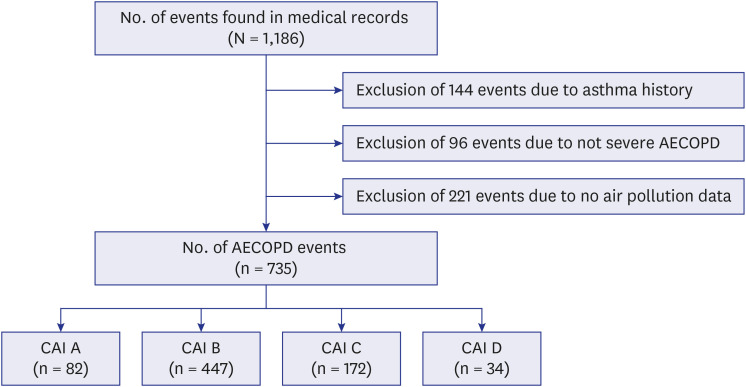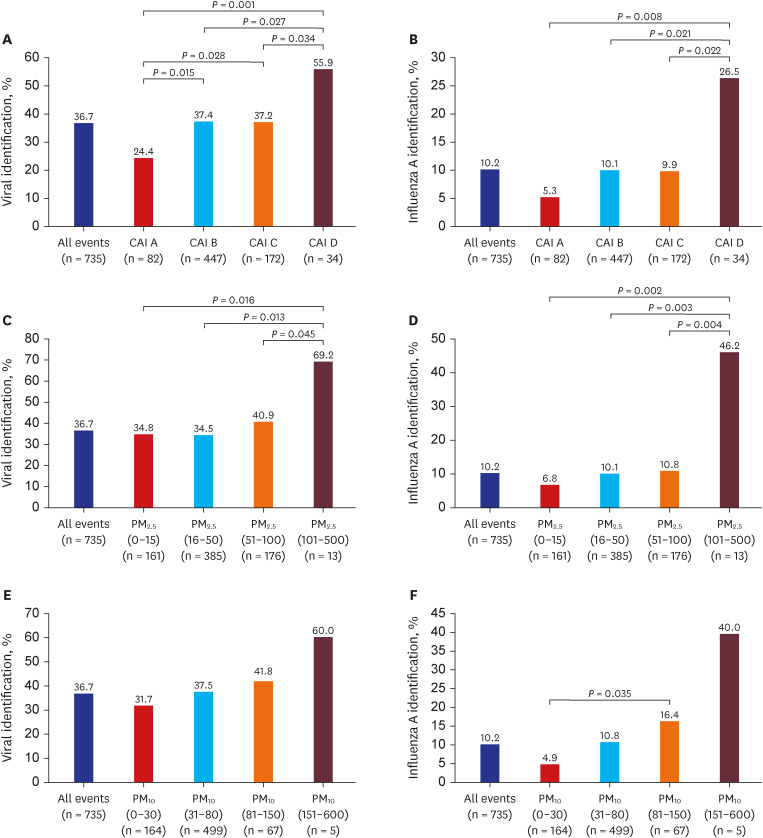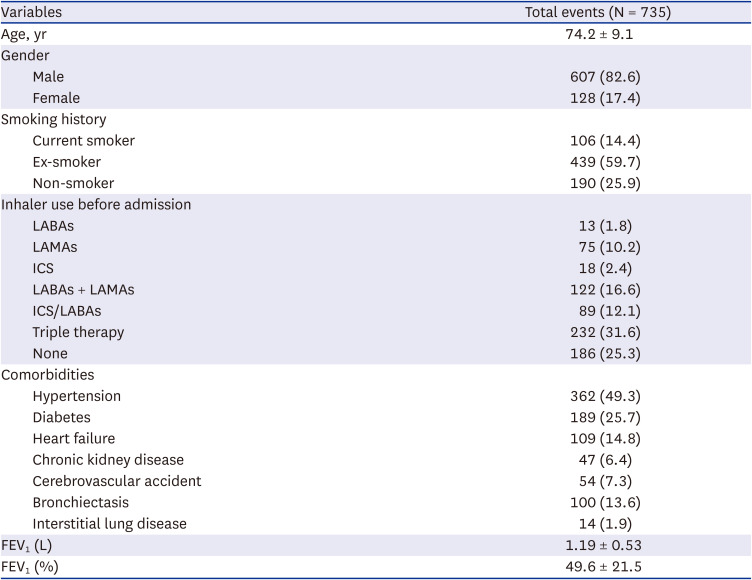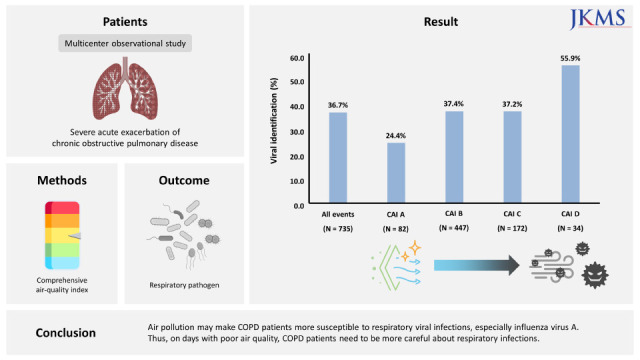1. Adeloye D, Song P, Zhu Y, Campbell H, Sheikh A, Rudan I, et al. Global, regional, and national prevalence of, and risk factors for, chronic obstructive pulmonary disease (COPD) in 2019: a systematic review and modelling analysis. Lancet Respir Med. 2022; 10(5):447–458. PMID:
35279265.
2. Yawn BP, Thomashow B. Management of patients during and after exacerbations of chronic obstructive pulmonary disease: the role of primary care physicians. Int J Gen Med. 2011; 4:665–676. PMID:
21941453.
3. Ritchie AI, Wedzicha JA. Definition, causes, pathogenesis, and consequences of chronic obstructive pulmonary disease exacerbations. Clin Chest Med. 2020; 41(3):421–438. PMID:
32800196.
4. Hansel NN, McCormack MC, Kim V. The effects of air pollution and temperature on COPD. COPD. 2016; 13(3):372–379. PMID:
26683097.
5. Jung EJ, Na W, Lee KE, Jang JY. Elderly mortality and exposure to fine particulate matter and ozone. J Korean Med Sci. 2019; 34(48):e311. PMID:
31833266.
6. Han C, Kim S, Lim YH, Bae HJ, Hong YC. Spatial and temporal trends of number of deaths attributable to ambient PM
2.5 in the Korea. J Korean Med Sci. 2018; 33(30):e193. PMID:
30034305.
7. Choi J, Oh JY, Lee YS, Min KH, Hur GY, Lee SY, et al. Harmful impact of air pollution on severe acute exacerbation of chronic obstructive pulmonary disease: particulate matter is hazardous. Int J Chron Obstruct Pulmon Dis. 2018; 13:1053–1059. PMID:
29681728.
8. Yang L, Li C, Tang X. The impact of PM
2.5 on the host defense of respiratory system. Front Cell Dev Biol. 2020; 8:91. PMID:
32195248.
9. Loaiza-Ceballos MC, Marin-Palma D, Zapata W, Hernandez JC. Viral respiratory infections and air pollutants. Air Qual Atmos Health. 2022; 15(1):105–114. PMID:
34539932.
10. Lee HW, Sim YS, Jung JY, Seo H, Park JW, Min KH, et al. A multicenter study to identify the respiratory pathogens associated with exacerbation of chronic obstructive pulmonary disease in Korea. Tuberc Respir Dis (Seoul). 2022; 85(1):37–46. PMID:
34666427.
11. Choi J, Oh JY, Lee YS, Min KH, Hur GY, Lee SY, et al. Harmful impact of air pollution on severe acute exacerbation of chronic obstructive pulmonary disease: particulate matter is hazardous. Int J Chron Obstruct Pulmon Dis. 2018; 13:1053–1059. PMID:
29681728.
12. Li J, Sun S, Tang R, Qiu H, Huang Q, Mason TG, et al. Major air pollutants and risk of COPD exacerbations: a systematic review and meta-analysis. Int J Chron Obstruct Pulmon Dis. 2016; 11:3079–3091. PMID:
28003742.
13. Song B, Zhang H, Jiao L, Jing Z, Li H, Wu S. Effect of high-level fine particulate matter and its interaction with meteorological factors on AECOPD in Shijiazhuang, China. Sci Rep. 2022; 12(1):8711. PMID:
35610290.
14. Morantes-Caballero JA, Fajardo Rodriguez HA. Effects of air pollution on acute exacerbation of chronic obstructive pulmonary disease: a descriptive retrospective study (pol-AECOPD). Int J Chron Obstruct Pulmon Dis. 2019; 14:1549–1557. PMID:
31371940.
15. Xia X, Yao L, Lu J, Liu Y, Jing W, Li Y. A comparison analysis of causative impact of PM2. 5 on acute exacerbation of chronic obstructive pulmonary disease (COPD) in two typical cities in China. Atmosphere (Basel). 2021; 12(8):970.
16. Aghapour M, Ubags ND, Bruder D, Hiemstra PS, Sidhaye V, Rezaee F, et al. Role of air pollutants in airway epithelial barrier dysfunction in asthma and COPD. Eur Respir Rev. 2022; 31(163):210112. PMID:
35321933.
17. Bayram H, Devalia JL, Sapsford RJ, Ohtoshi T, Miyabara Y, Sagai M, et al. The effect of diesel exhaust particles on cell function and release of inflammatory mediators from human bronchial epithelial cells in vitro. Am J Respir Cell Mol Biol. 1998; 18(3):441–448. PMID:
9490663.
18. Takizawa H, Ohtoshi T, Kawasaki S, Abe S, Sugawara I, Nakahara K, et al. Diesel exhaust particles activate human bronchial epithelial cells to express inflammatory mediators in the airways: a review. Respirology. 2000; 5(2):197–203. PMID:
10894110.
19. Montgomery MT, Sajuthi SP, Cho SH, Everman JL, Rios CL, Goldfarbmuren KC, et al. Genome-wide analysis reveals mucociliary remodeling of the nasal airway epithelium induced by urban PM
2.5
. Am J Respir Cell Mol Biol. 2020; 63(2):172–184. PMID:
32275839.
20. Jia J, Xia J, Zhang R, Bai Y, Liu S, Dan M, et al. Investigation of the impact of PM
2.5 on the ciliary motion of human nasal epithelial cells. Chemosphere. 2019; 233:309–318. PMID:
31176132.
21. Li J, Hu Y, Liu L, Wang Q, Zeng J, Chen C. PM2.5 exposure perturbs lung microbiome and its metabolic profile in mice. Sci Total Environ. 2020; 721:137432. PMID:
32169651.
22. Li N, He F, Liao B, Zhou Y, Li B, Ran P. Exposure to ambient particulate matter alters the microbial composition and induces immune changes in rat lung. Respir Res. 2017; 18(1):143. PMID:
28743263.
23. Mariani J, Favero C, Spinazzè A, Cavallo DM, Carugno M, Motta V, et al. Short-term particulate matter exposure influences nasal microbiota in a population of healthy subjects. Environ Res. 2018; 162:119–126. PMID:
29291434.
24. Niemeier-Walsh C, Ryan PH, Meller J, Ollberding NJ, Adhikari A, Reponen T. Exposure to traffic-related air pollution and bacterial diversity in the lower respiratory tract of children. PLoS One. 2021; 16(6):e0244341. PMID:
34166366.









 PDF
PDF Citation
Citation Print
Print




 XML Download
XML Download